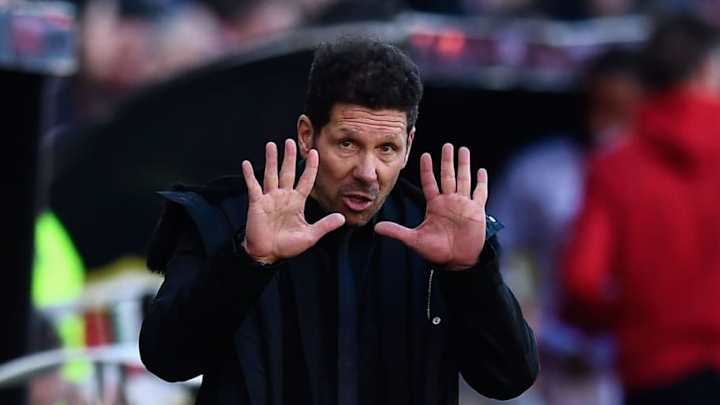Atletico Madrid: How Los Rojiblancos & Diego Simeone Redefined Catenaccio

In an era that has seen clubs attempt to mimic idyllic styles of football like 'Total Football' or 'Joga Bonito' week in, week out, Atletico Madrid have no shame in harking back to a less aesthetically pleasing style of football.
Preferring clean sheets to high-scoring wins and defensive resoluteness to attacking proficiency, Diego Simeone has offered a successful alternative to how today's football could - and sometimes should - be played.
Ahead of Atletico Madrid's Champions League round of 16 first leg tie against Juventus, we take a look at how Simeone's side have redefined the famous Italian tactic of Catenaccio, to create its modern day equivalent: Cholismo.
Translated from Italian to English to mean 'bolt', Catenaccio is basically the tactic to absorb pressure, drawing opponents on before hitting them on the counter attack. In essence, it was a
pragmatic approach to the beautiful game in its simplest form - yet there is beauty is in its simplicity.
First coined by Karl Rappen in the 1930s for Swiss side Servette as well as the Swiss national team, which involved a narrow back four with one sweeping behind the rest of the defence who was known as 'the bolt', which sat behind a narrow midfield that flooded the centre. However, it wasn't until Catenaccio was embraced by a post-war Italy that the tactic came to mainstream prominence.
The style's biggest exponents in Italy were Nereo Rocco while in charge of Milan - winning the European Cup in 1963 and 1969 - and Inter manager Helenio Herrera, who won the European Cup in 1964 and 1965 utilising Catenaccio.
Inter Milan manager Helenio Herrera with AC Milan counterpart Nereo Rocco 1967/68 pic.twitter.com/KIbZ5rpkui
— VintageFooty (@VintageFooty) February 16, 2015
Herrera's approach involved having enough numbers at the back - usually a four in the defence - to ensure that the defence was secure when going forward, something tactically prevalent when watching Simeone's Atletico Madrid side.
Since his appointment in December 2011, Simeone's side have always been known - and admired - for their defensive approach, involving a vertically compact and narrow 4-4-2 formation.
Like Catenaccio, Simeone's premise is to congest central midfield and overload wide areas, while dropping deeper when the opposition are on the attack, with an emphasis on minimising risk having the ability to defend slender leads against more talented outfits.
Where Simeone's ideas differ in two key areas. The first is how they press, which isn't continuous like most teams favour across Europe, but is done as a result of a bad touch or when their shape is stretched; although it is aggressive when initiated.
Secondly is how the team attack, with the two biggest avenues to goal coming from counter attacks of set pieces, while there is a heavy reliance on individual skill and flair, rather than a collective team move.
The nuances in Simeone's philosophy has seen it earn its own title stemming from his own nickname of El Cholo called Cholismo - individual skills underpinned by team instruction, which perfectly sum up an Atletico Madrid side. An Atletico Madrid side who have offered a successful antithesis to more eye-catching styles that he's come up against - most notably Real Madrid and Barcelona.
🔵🔝 @FCBarcelona_es 🔝🔴
— LALIGA (@LaLiga) February 17, 2019
➕ 7 puntos que el Atlético de Madrid
➕ 9 puntos que el Real Madrid
➕ 17 puntos que el Sevilla FC #LaLigaSantander pic.twitter.com/DGvB5jOGtD
Thibaut Coutois and Jan Oblak have been steady pairs of hands, earning plenty of clean sheets that have been a cornerstone to Simeone's success; while full-backs Juanfran and Filipe Luis offered the perfect balance to defence and attack.
Saul Niguez and Koke have regularly played as inverted wingers to help narrow the midfield, with Gabi leading the team with a combative attitude in the centre of the park that was matched by his quality on the ball, while Diego Costa and Antoine Griezmann have long provided the individual skill in the attacking third for Cholismo to work.
It's a tactic that has brought Simeone plenty of success during his time in charge in the Spanish capital, winning two Europe League titles, two UEFA Super Cups, the Spanish Super Cup, Copa del Rey, and perhaps his crowning glory, La Liga in 2014.
Simeone has also guided Los Rojiblancos to two Champions League finals in 2014 and 2016, which both resulted in defeat to bitter rivals Real Madrid, although it was their run to the 2016 final, particularly the quarter and semi-finals, that offered the greatest exemplification of what the Argentine had achieved with his Atletico Madrid squad.
Los Rojiblancos overcame a treble-chasing Barcelona in the quarter-finals with a narrow 3-2 aggregate win, as a Griezmann brace and some resolute defending in the second-leg seeing them through. In the semi finals Atleti knocked out Pep Guardiola's Bayern Munich, who were also chasing the treble.
Like most things however, Simeone has been forced to evolve with time, with some additions working better than others. Santiago Arias looks to be a solid long-term replacement for Juanfran at right-back, while more time will be required for Thomas Lemar to settle, with his arrival signalling the club's intent to ass some more natural width to their squad.
Ahead of their upcoming Champions League round of 16 first-leg tie against Juventus, Giorgio Chiellini described Atletico Madrid as 'more Italian than Spanish' which aptly sums up Diego Simeone's side. And he's right. Atleti are the modern day equivalent of the Juventus side of the 1980s and the Inter side of the 1960s. They may not be the prettiest team in Europe; but they might be the most effective.
